Film Name:金刚:骷髅岛 / BKong: Skull Island
[Warning: This article contains spoilers. Proceed with caution.]
The King Kong franchise stands as an unavoidable peak in monster cinema. Since 1933, it has cemented its legendary status. Setting aside the uneven sequels that followed, Peter Jackson’s 2005 adaptation of “King Kong” demonstrated the perfect blend of power and tenderness… As the new “King Kong” film co-produced by Legendary and Warner Bros., even if you know nothing about the series beforehand (like me), it won’t hinder your enjoyment of the movie.
Let me get this out of the way: approach this film with the right mindset. It’s a competent Hollywood assembly-line blockbuster—a satisfyingly large serving of popcorn that’s sweet and delicious, with a few extra little surprises thrown in. But that’s about it. So don’t put it on a pedestal, and certainly don’t tear it down for its flaws or lack of depth. After all, its purpose is simply to deliver a satisfying thrill ride.
Monsters, adventure, epic battles… not a single one missing.
In my view, the greatest strength of Kong: Skull Island lies in its straightforwardness and honesty. Director Jordan knew full well that audiences were primarily there to witness the mightiest ape in history unleash his power. Consequently, he had Kong make an early appearance, stunning two pilots before the main story even began.
The setup explaining why and how the team ends up on Skull Island is fast-forwarded as much as possible, avoiding any unnecessary delays: Professor Landa and Brooks’ relentless pursuit of the “Kong Project” finally secures approval for the expedition. They then recruit Captain Conrad as their field guide and obtain military protection from Colonel Packard’s squad. Additionally, Weaver, who claims to be an anti-war photographer, joins the expedition…

A scholar obsessed with mysterious creatures unknown to the world, a reclusive yet exceptionally skilled male lead, a beautiful, capable, and courageous female lead, and a group of formidable, battle-hardened American soldiers fresh off the Vietnam battlefield—everything is so conventionally set, the most classic (clichéd) cast for an adventure journey.
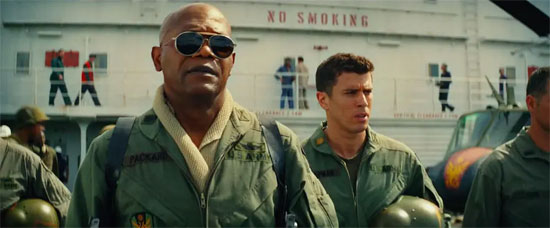
After assembling, the group marches off to their destination with high spirits. The soldiers are full of vigor, the scholars are eager to begin, and the protagonists are filled with doubts. Thus, they arrive at the mysterious Skull Island.
Establishing a forward base, they drop several bombs ostensibly for “reconnaissance.” The relentless advance of the helicopter fleet not only evokes “Apocalypse Now” but also makes one feel that every Hollywood blockbuster resembles a U.S. military recruitment ad… Just as everyone is happily humming tunes, a sudden attack throws them into confusion.
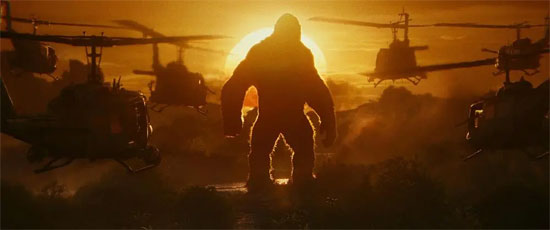
The film’s “straight to the point” style is immediately apparent. Unlike some others in the genre that play coy, dragging out the monster’s reveal until a third or even halfway through the film, this one doesn’t waste time.
—Here, barely half an hour in, King Kong not only emerges immediately after the crew lands to teach the intruders a lesson, but also delivers a lethal beating from the very first strike: “Daring to trespass on my territory? You’ve come looking for death!”
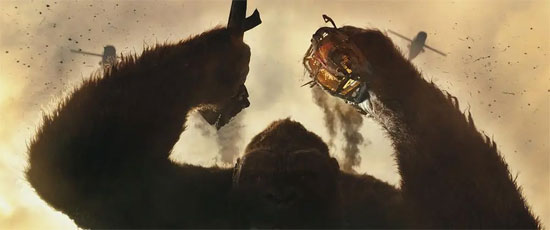
Simple, brutal, and direct—how could mere mortals stand against a god-like Kong? After this battle, all the helicopters are destroyed, and Colonel Packard’s men suffer heavy casualties. In this unequal fight, the adventurers finally understand what despair truly means.
The first encounter between Kong and humanity boasts many strengths. Beyond the thrilling action sequences, the film achieves notable artistic merit in its framing and visuals.
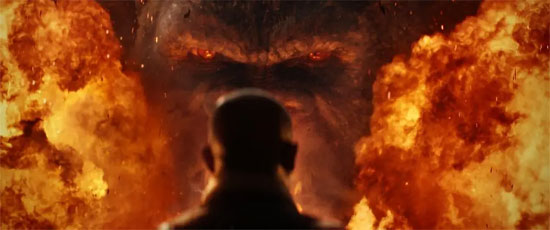
Take the scene after the explosion: Kong and Colonel Packard locked in a merciless stare amidst the inferno, radiating a comic-book-like visual impact and ritualistic intensity.
After narrowly avoiding annihilation, the survivors split into three groups:
The first was the military unit led by Colonel Packard, including Professor Landa and the Captain. Even after learning the truth, Packard remained fixated on vengeance, creating a palpable tension within the group.
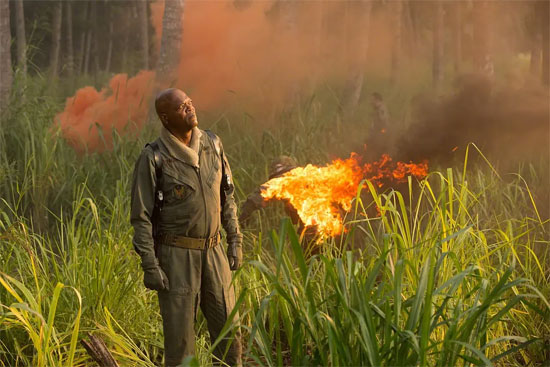
The second group comprised a motley crew including Conrad, Weaver, and others—adventurers, photographers, scholars, soldiers, and crew members. They later encountered a local indigenous tribe, making their journey the most compelling and true to the theme of “adventure.”

The third team comprised the solitary Major Chapman. Since all heavy weaponry was under his control, locating him became Packard’s top priority. Unfortunately, Chapman soon met his demise…

To be called an “adventure journey,” bizarre natural landscapes and exotic creatures are indispensable along the way. Beyond Kong as the central protagonist, the various monsters are the true stars that elevate the film (after all, it is a monster movie).
Take the giant-legged jungle spiders that silently lunge to kill; or the monstrous birds dubbed Icarus Wings, which snatch victims skyward at the slightest distraction before tearing them apart; or the colossal squid lurking silently beneath the swamp waters, which not only battles Kong but ultimately becomes his meal…
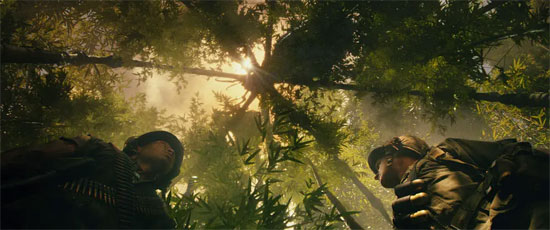
Of course, not all creatures are terrifying. The isolated reef ox, suddenly surfacing from the water, has a surprisingly docile nature—leave it alone, and it won’t bother you. Then there’s the giant spore mantis, resembling a dead tree trunk. While its massive, intimidating appearance might startle at first glance, a closer look reveals unexpectedly endearing qualities.
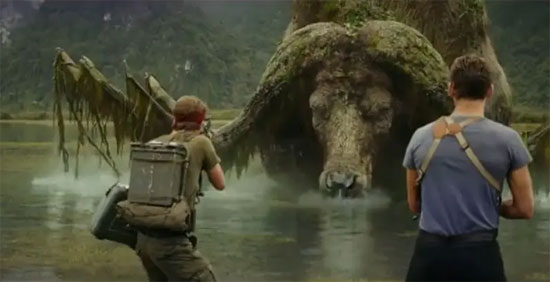
Flipping through the released concept art, I noticed many native creatures hadn’t made an appearance (or weren’t prominent enough). This truly highlights how teeming with life Skull Island is. Thanks to these diverse and bizarre creatures, the film gains so much freshness and charm.
Having covered one major highlight, let’s return to the main storyline. Conrad’s team soon encounters the island’s indigenous inhabitants, alongside Mark, a WWII American airman who’s lived on Skull Island for 28 years.
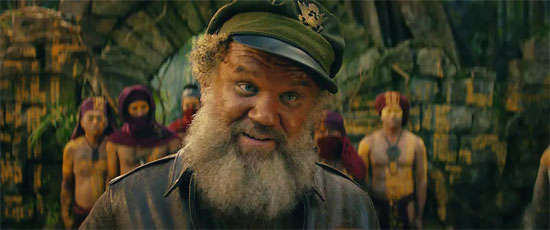
Mark first defuses the tense standoff between the two groups, then guides the newcomers on a hike through the primitive village. He proceeds to explain the situation: Kong is the god of Skull Island. It’s not merely that the natives worship him as a deity—he also shoulders the crucial duty of guarding the island and battling monsters.

Hmm, the familiar trope. Kong, who moments ago was locked in a deadly battle with humans (albeit provoked by them), is actually an indispensable guardian deity. He must confront monsters constantly erupting from the earth while also battling the true threat to global security: the Skull Lizard.
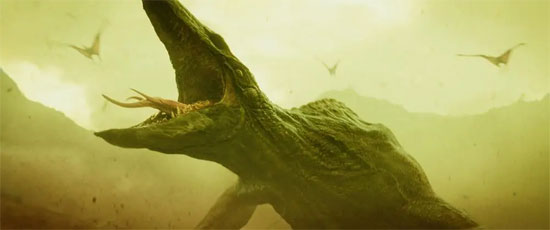
Such reversals and subsequent reconciliations no longer stir the audience’s nerves. It feels like a predictable progression—if that’s how you choose to play it, then that’s how we’ll watch it.
To reach the rendezvous point as quickly as possible, Mark teamed up with Conrad and others to repair the airship, then set off downstream…
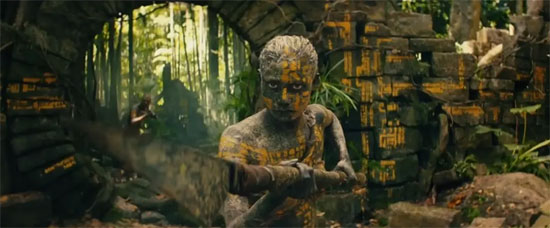
It must be said that the film’s handling of the indigenous people segment is rather disappointing. It completely fails to depict the clash between modern and primitive civilizations. Communication is reduced to silent nods, while other interactions are limited to Weaver taking photos and the natives guiding and bidding farewell. Even considering time constraints, such a perfunctory treatment is a shame, reducing it to mere symbolic imagery.
Soon after, the two groups meet. Driven by Colonel Packard’s hidden thirst for vengeance, the crew once again marches toward death…
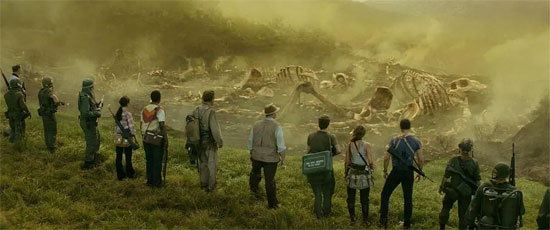
The remaining plot points need little elaboration, largely revolving around battle, sacrifice, hatred, and reconciliation.
The appeal of popcorn cinema lies precisely here. Upon reflection, the narrative feels rather predictable—nothing to write home about. Yet this doesn’t diminish the visceral thrill and cathartic release we experience during the viewing.
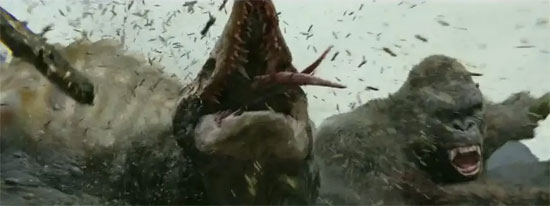
Put another way, regardless of other aspects, the film’s value is justified by the climactic battle between King Kong and the Skeleton Lizard alone—a spectacle you don’t witness every day.
A superficial anti-war sentiment
The anti-war sentiment in “Kong: Skull Island” is an undeniably prominent and inescapable theme. In such a high-octane action film, weaving an anti-war message throughout is both the smartest and most necessary design choice. Ultimately, however, director Jordan’s exploration of this theme remains superficial, effectively fulfilling its role as a veneer for a commercial blockbuster. Had it delved deeper, the film’s artistic stature would likely have been entirely different.
This sentiment is established from the very beginning: American pilot Mark and Japanese pilot Gunpei both crash-land on Skull Island. Even without their aircraft, the two survivors are determined to fight to the death. Just as their battle reaches a fever pitch, King Kong makes his awe-inspiring entrance. and the men instinctively halt their fight. Before this godlike colossal ape, humanity appears utterly insignificant and fragile, rendering their ideological differences and war-fueled hatred utterly trivial.
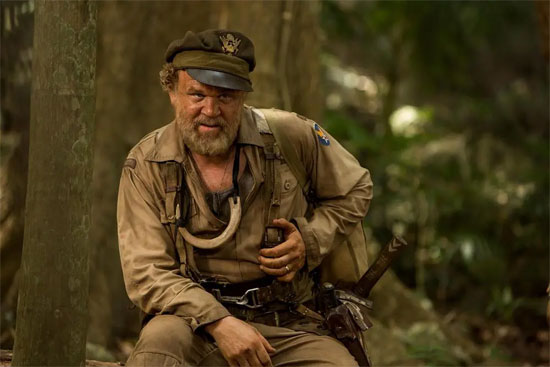
Judging by Mark’s words and actions afterward, having survived Skull Island, he and Gunpei became inseparable friends, their former animosity long since dissipated—a design choice that elicits a knowing smile.
Additionally, the story is set in 1973, on the eve of the Vietnam War’s conclusion. The soldiers under Colonel Packard’s command all anticipated returning home. Major Chapman was a tender father deeply concerned for his son, while Mills agonized over his girlfriend’s infrequent letters and her true feelings. Slyfka was just an ordinary young man who loved baseball and had a strict father, while Cole remained perpetually mature and steady, yet unable to sleep at night…

Each soldier given lines and characterization had their own story, and their portrayals were highly archetypal. While compelled to obey their commander Packard’s orders, they yearned for peace and tranquility. It was slightly regrettable that these emotions often felt simplistic and superficial, barely touched upon before being swiftly moved past.
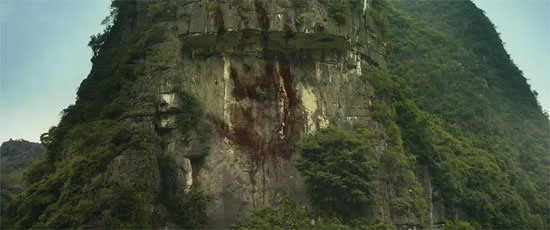
When Packard and the others saw Kong’s bloody handprint, they realized he was wounded. As they departed, Cole held his AK-47 and recounted the story of the Vietnamese farmer. His subsequent words became the film’s defining moment on the anti-war sentiment: Often, the enemy doesn’t exist until you go looking for him.
After this, the film never again presents a more ingeniously conceived scene or line of dialogue. Even Kong’s interactions with Conrad, Weaver, and others feel somewhat contrived, as if reconciliation were the sole purpose.
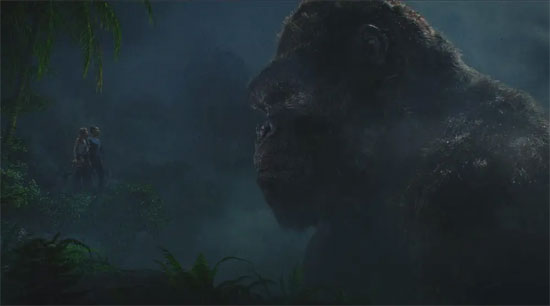
Regardless, in terms of depth and meaning, the film delivers sufficiently well. It’s accessible and understandable to all viewers. There’s no need for excessive regret—the filmmakers themselves never intended it to be overly complex or profound.
Face-scanning performance—just give us a familiar look.
A blockbuster popcorn flick wouldn’t be complete without a few A-list stars to carry the weight. Kong: Skull Island boasts an impressive cast, featuring standout performers like Tom Hiddleston, Brie Larson, and Samuel L. Jackson. Additionally, familiar faces like John Goodman (Professor Landa), John C. Reilly (Veteran Mark), and Toby Kebbell (Major Chapman) grace the screen. Even supporting actors like Corey Hawkins (Brooks) and Shea Whigham (Cole) won’t be strangers to fans of American TV series…
In short, the sheer star power alone makes this film feel familiar and welcoming—but perhaps because everyone knows what it means to star in a monster movie, the performances largely remain at that level of “face-filling.”
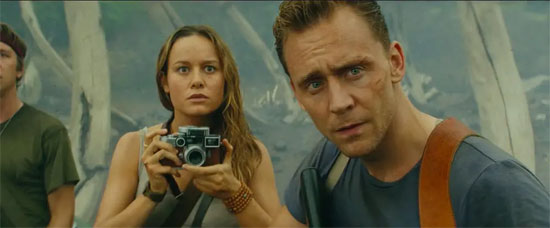
Beyond the symbolism and formulaic elements, do you genuinely believe there’s anything particularly striking about Tom Hiddleston’s performance beyond his handsome looks? Not to mention Larson’s underwhelming performance throughout… The rest of the cast follows suit, as if confined within a predetermined framework where everyone simply checks off their assigned tasks—perhaps a bit harsh, but that’s the reality…

By contrast, Samuel L. Jackson’s Colonel Packard stands out as the most compelling character. a hardened soldier who spent his life on the battlefield and yearned to remain there forever. He craved combat and bloodshed, vowing to avenge his fallen comrades while leading the survivors toward self-destruction. Even as he faced utter isolation and betrayal before his death, he showed no remorse—the pinnacle of the film’s acting, and the only truly memorable performance.
As for the ever-present awkwardness of the “universe sweetheart” trope (you’ve been waiting for this part, right?), it plays an equally uncomfortable role in this film. This awkwardness isn’t merely about her being the sole Asian member of the expedition. While our sweetheart is undeniably beautiful, the character she portrays, Shan, remains an oddity within the group. While others emerge disheveled and bedraggled after their struggles, she remains flawlessly pristine, her hair perfectly coiffed. From her clothing style to her overall persona, she constantly pulls us out of the narrative…
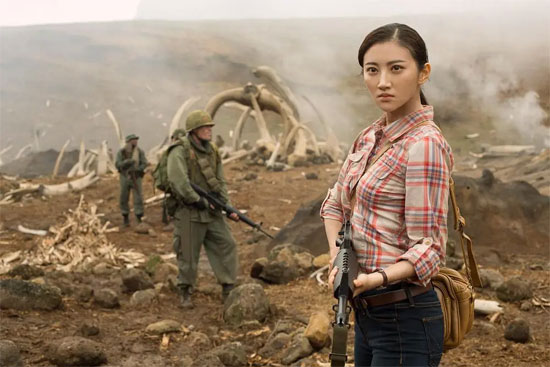
Fortunately, her role and screen time are negligible to the film’s overall quality, merely leaving a faint trace of presence without detracting from the experience. Otherwise… Precisely because Jing Tian’s role is so inconsequential, it would be irresponsible to harshly criticize Kong: Skull Island solely over this minor cameo.
Don’t forget—the true star of this film is King Kong!
Through this project, Industrial Light & Magic once again solidified its status as an industry titan. The film’s most celebrated aspects are its numerous special effects sequences and action scenes featuring Kong and other monsters.
Perhaps seeing Kong battle monsters is all we should ask for.
Please specify:Anime Phone Cases » Kong: Skull Island 金剛:骷髏島 2017 Film Review: The Deluxe Family Bucket Popcorn You Want